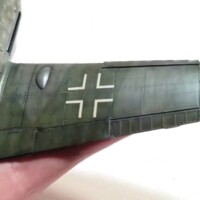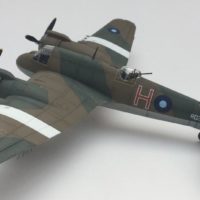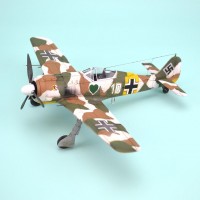Camouflage & Markings: Fiat CR.42 Falco, the ultimate biplane fighter
The Fiat CR.42 Falco holds a unique place in aviation history as World War II's ultimate biplane fighter. Quite possibly, it was also the best biplane fighter aircraft ever produced.
Its designer was Celestino Rosatelli, who had a history of designing successful biplanes, including the earlier Fiat CR.32 which performed well during the Spanish Civil War. In contrast with the German and Soviet conclusions from the same conflict, the Italians chose to double-down on biplane design for their next generation fighter.
The resulting Fiat CR.42 Falco combined the traditional biplane agility with a more powerful engine and improved aerodynamics. The type first flew on May 23, 1938, and entered service in 1939. It served primarily with the Regia Aeronautica. There were 272-290 CR.42s in front line service when Italy entered the Second World War in June 1940, with another 40 aircraft temporarily out of commission and 40 more yet to be delivered. Three Stormi had the type in Italy, a fourth operated it in Libya and two squadrons (413th and 414th) operated it alongside the CR.32 in Italian East Africa.
The CR.42 made its combat debut during the short Italian involvement in the invasion of France in June 1940. They took a small but notable part in the Battle of Britain. They went on to fight in Greece and North Africa during 1941-1942. After Italy's armistice in 1943, some CR.42s were used by the Italian Co-Belligerent Air Force as trainers, while others were seized ground-attack missions.
Despite its comparably poor combat record, the Falco was robust, reliable, maneuverable and liked by its pilots.
During the Battle of Britain, the Fiat CR.42 was employed as part of the Corpo Aereo Italiano (CAI). The CAI conducted three recorded daylight bombing raids on the UK, with the largest operation involving 10 BR.20 bombers and 40 CR.42s targeting Harwich.
The Italians lost three bombers and three CR.42 fighters during this raid, with three additional bombers crashing back in France and Belgium. Overall, the CR.42s proved inadequate in the escort role, facing the superior opposition of RAF Hurricanes and Spitfires.
The profile shows CR.42 of the CAI. Originally belonging to 85th Squadron, 18th Group, 3rd Wing Regia Aeronautica, it was transferred to the 56th Wing in autumn 1940 and took part in the operations over England.
Fiat C.R.42 of Regia Aeronautica's 162nd Squadron (162a Squadriglia), 161st Autonomous Land Fighter Group (46o Gruppo Autonomo C.T.) based in Maritsa, Rhodes, Greece in 1942.
This aircraft, rebuilt using many original parts, has been on display since 2005 at the Italian Air Force Museum in Vigna di Valle, not far from Rome.
Fiat C.R.42 of Regia Aeronautica's 20th Squadron (20a Squadriglia), 46th Group (46o Gruppo) 15th Wing (15o Stormo Assalto), based in El Adem in 1942.
Fiat C.R.42 of Regia Aeronautica's Fighter-Attack School, based in Ravenna in 1942.
Fiat C.R.42 of Regia Aeronautica's 15th Wing (15o Stormo Assalto), based in Barca, Cyrenaica, Libya in 1942.
C.R.42CN (Caccia Notturna) night fighter; note the long exhaust flame dampeners.
The aircraft was also used by other air forces:
Hungary
The first foreign customer of the CR.42 was the Royal Hungarian Air Arm, which placed orders for 18 aircraft during the summer of 1938. During 1939, Hungary ordered an additional 50 aircraft. All of them were delivered before June 1940.
Hungary used their new fighter for the first time during the Yugoslavian campaign in April 1941, without much success. For example, it was discovered that the CR.42s were incapable of intercepting the Yugoslav Blenheims.
In contrast, the type was notably effective on the Eastern Front during the Barbarossa campaign, facing an outdated Soviet opposition, mostly consisting of Polikarpov I-16s.
Despite this success, by the end of 1941 it was all over: the remaining Hungarian CR.42s were pulled back to training duties.
Belgium
Belgium ordered 40 of the Fiat's fighter in December 1939, with deliveries starting in March 1940. The aircraft were swiftly allocated to Squadron 3/II/2Aé (Red Cocotte) and 4/II/2Aé (White Cocotte) based at Nivelles. Sadly, during the German onslaught on 10 May 1940, the new Belgian fighters did not manage to make any difference; in fact, more than half of them were destroyed during the German bombing raid on Brustem. In the few aerial encounters that ensued, the aicraft proved to be hopelessly outclassed against the German Bf 109. The remaining aircraft escaped to France, where they were later taken over as war booty by the Germans. The final fate of the Belgian Fiats remains unclear, but it is likely that they ended up as fighter-trainers at JG 107 at Toul.
Sweden
During the early part of 1940, the Finnish-Soviet Winter War was ongoing. The Swedish volunteer unit F 19 (Flottilj 19) defended northern Finland against Soviet bombing raids but needed better fighters than their Gloster Gladiators. In early February 1940, a nationwide fundraising campaign began in Sweden, resulting quickly in the first contract for five Fiat CR.42s, followed by a second for seven more on February 24. The CR.42 was chosen for its immediate availability and the ease with which skis could be fitted for operations in nordic winter conditions.
With the ending of the Winter War on 13 March, Finland decided not to accept the aircraft, whereupon the Swedish Air Force adopted them for use as reconnaissance aircraft with F 3 at Linköping. The Italian aircraft got the Swedish designation J 11 and the orders were extended to cover 72 aircraft in total, serving also with F 9 at Säve, Gothenburg, and with that unit's detachment in Kiruna to the north. Desipte its apparent obscolescence, the CR.42 remained in first-line Swedish service until March 1945.
J 11 of Svenska Flygvapnet's Wing F 9, based in Kiruna, Sweden, in 1942. Note the skis that replaced the original wheeled undercarriage for winter operations in the northern climate.
Germany
After Italy signed the armistice with the Allies on September 8, 1943, the Germans moved in to occupy the northern part of the country, seizing the aircraft production facilities. They promptly ordered 200 Fiat CR.42LW (LW=Luftwaffe) for the Luftwaffe to use for night harassment and anti-partisan roles. The aircraft was equipped with exhaust flame dampers, a pair of 12.7mm machine-guns and underwing bomb racks for four 50kg bombs. About 150 machines were eventually delivered, equipping two Nachtschlachtgruppen, NSGr 9 at the Eastern Front and NSGr 7 in Croatia. NSGr. 20 based in France also used an unknown number of CR.42s.
Fiat C.R.42 of Luftwaffe's JG/107, based in Nancy-Essay, France in 1944. It is possible that this was one of the ex-Belgian CR.42s seized by the Luftwaffe.
The profiles in this article have been drawn by Mr. M L Watts, via Wikimedia commons.












Still one of those aircraft that I would like to build, Martin @editor
These profiles will be very helpful, thanks for sharing.
Yes it is one of the good-looking ones :). Thank you
Excellent reference article, Martin!
Thanks!
Cheers @fiveten!
Just added one of these to my stash so perfect timing with this article!
Oh, great! What is the kit @embersonfedders?
The 1/72 Italeri kit, Battle of Britain memorial edition, although I plan to make one of the versions from the Libyan desert!
Very informative, I didn’t know this aircraft saw so much service in foreign air forces.
Glad to hear that, @ssgt.